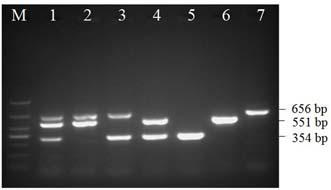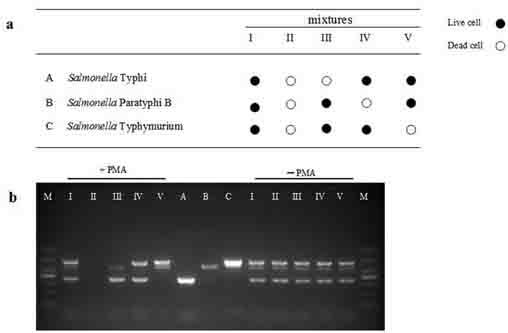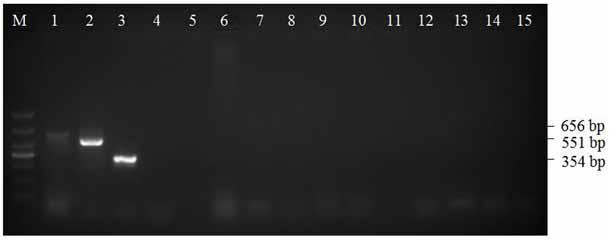Method for detecting live salmonella typhimurium, salmonella paratyphi b and salmonella typhi in food simultaneously and rapidly
A technology for Salmonella typhi and paratyphoid B, which is applied in the field of microbial detection, can solve the problems of high labor intensity, time-consuming and high cost, and achieves the effects of simple operation, high efficiency and simple result judgment.
- Summary
- Abstract
- Description
- Claims
- Application Information
AI Technical Summary
Problems solved by technology
Method used
Image
Examples
Embodiment
[0031] Step 1, Food Sample Pretreatment
[0032] Weigh 1 g of food sample, add 9ml of PBS, grind to make a homogenate, centrifuge at 900 g for 5 min, remove the enlarged food residue, and take the supernatant (this process must be performed aseptically).
[0033] Step 2, PMA processing
[0034] PMA was dissolved in dimethyl sulfoxide (DMSO), prepared into a 0.5 mg / mL PMA solution, and stored at -20°C in the dark. Take 500 μL of the prepared bacterial suspension and place it in a 1.5 mL microcentrifuge tube, add 3 μL of 0.5 mg / mL PMA solution to make the final mass concentration of PMA 3 μg / mL; Incubate in the dark at room temperature for 5 min, and expose to a 500 W halogen lamp for 5 min. When cross-linking with light, place the sample on ice (to avoid overheating), and place the cross-linked suspension at 10,000 g at a distance of 20 cm from the light source. After centrifugation for 5 min, the resulting pellet was used for DNA extraction.
[0035] Step 3, Genomic DNA Ext...
PUM
 Login to View More
Login to View More Abstract
Description
Claims
Application Information
 Login to View More
Login to View More - R&D
- Intellectual Property
- Life Sciences
- Materials
- Tech Scout
- Unparalleled Data Quality
- Higher Quality Content
- 60% Fewer Hallucinations
Browse by: Latest US Patents, China's latest patents, Technical Efficacy Thesaurus, Application Domain, Technology Topic, Popular Technical Reports.
© 2025 PatSnap. All rights reserved.Legal|Privacy policy|Modern Slavery Act Transparency Statement|Sitemap|About US| Contact US: help@patsnap.com



